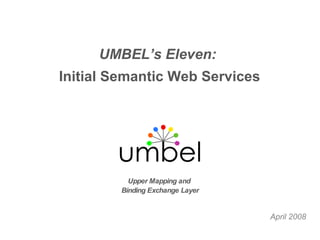UMBEL Semantic Web Services
- 1. April 2008 Upper Mapping and Binding Exchange Layer UMBELŌĆÖs Eleven: Initial Semantic Web Services
- 2. UMBEL is . . . . . . a lightweight reference structure for placing Web content and data in context with other data. . . . is comprised of about 21,000 subject concepts and their relationships ŌĆö with one another and with external vocabularies and named entities .
- 3. Subject Concepts 21,000 defined reference points in information space Means to assert what a given chunk of content is about Enable similar content to be aggregated Place content in context with other content Aggregation points for tying in named entities Totally derived and a subset of OpenCyc, the open source version of the Cyc knowledge base http://www.opencyc.com http ://www.cycorp.com
- 5. Named Entities The places , events , people , objects , and specific things of the real world Literally millions of notable instances Each belongs to one or more subject concept(s) Currently, the predominate basis for Linked Data Important sources include Wikipedia (Yago) and other public sources Can be readily mixed-and-matched with private entities
- 6. UMBEL is Middleware UMBEL ontology is based on RDF RDF Schema vocabulary of SKOS (Simple Knowledge Organization System) OWL Full to aid class, domain and range relationships with external ontologies Provides excellent interoperability Any external content (ontologies + named entities) Any external content (ontologies + named entities) ’āĀ ’ā¤ UMBEL ’āĀ OpenCyc (inferencing, structure and other tools)
- 7. UMBEL is a Roadmap A set of roadsigns to help find related content A contextual way to get from one concept space to another More detailed maps used for specific domains
- 8. UMBEL is a Backbone The backbone to UMBEL is the relationships amongst its subject concepts The backbone provides the contextual graph for inter-relating content The backbone is a reference structure for more specific domains or ontologies The backbone is contextual , and relatively stable and constant
- 9. Exploding the Domain Each subject concept is an individual of the skos:Concept class, which are themselves OWL classes Since subject concepts are classes, can relate to external ontology classes using rdfs:subClassOf and owl:equivalentClass Under right circumstances, can also inherit properties Through inferencing, silo data now can inherit open world understanding, therefore: ’āĀ exploding the domain
- 10. A Deep Dive into the Backbone . . . . . . all 21,000 nodes
- 11. A Deep Dive into the Backbone . . . . . . top 750 nodes
- 12. A Deep Dive into the Backbone . . . . . . top 350 nodes
- 13. A Deep Dive into the Backbone . . . . . . zeroing in on ŌĆśautomobilesŌĆÖ
- 14. A Deep Dive into the Backbone . . . . . . zeroing in on ŌĆśSaabsŌĆÖ
- 15. The First Eleven Web Services
- 16. UMBELŌĆÖs Eleven Find Subject Concepts Subject Concept Report Subject Concept Detailed Report List Sub-Concepts & Sub-Classes List Super-Concepts & Super-Classes List Equivalent External Classes Verify Sub-Class Relationship Verify Super-Class Relationship Verify Equivalent Class Relationship Subject Concepts Explorer Yago Ontology
- 17. Demos, Docs & APIs
- 19. Subject Concept Detailed Report
- 21. YAGO Ontology
- 22. Why Important to the Semantic Web? Context, Context, CONTEXT For Linked Data Context ! For Web Search: Infinite facets Disambiguation Cleaner navigation For Legacy Data Stovepipes: Making the connections Closed World schemas become Open World information Context !
- 23. Play for Yourself Access the UMBEL Web services at: http://umbel.zitgist.com Thanks to for hosting us !























